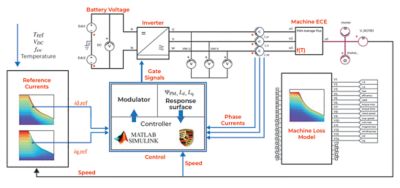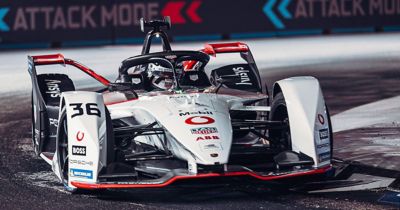-
United States -
United Kingdom -
India -
France -
Deutschland -
Italia -
日本 -
대한민국 -
中国 -
台灣
-
Ansys stellt Studierenden auf dem Weg zum Erfolg die Simulationssoftware kostenlos zur Verfügung.
-
Ansys stellt Studierenden auf dem Weg zum Erfolg die Simulationssoftware kostenlos zur Verfügung.
-
Ansys stellt Studierenden auf dem Weg zum Erfolg die Simulationssoftware kostenlos zur Verfügung.
-
Kontakt -
Karriere -
Studierende und Akademiker*innen -
Für die Vereinigten Staaten und Kanada
+1 844,462 6797
ANSYS ADVANTAGE MAGAZINE
May 2022
Racing through the streets of some of the most iconic cities in the world, some of the biggest drivers and teams in motorsports compete in the ABB FIA Formula E World Championship. This racing series is designed to push the limits of electric vehicle technology. During these high-speed, single-seater matchups, world-class drivers test their skills over a period of 45 minutes at speeds up to 174 mph (280 km/h) through winding, narrow urban racetracks.

With an ABB Formula E mandate on total energy consumption per team, wins are not just defined by speed, but also by kilowatt hours, so the efficiency of the race car’s powertrain is critical to a team’s success. For the TAG Heuer Porsche Formula E Team, a win on a race day depends, in part, on the team’s access to a simulation environment that can help them quickly analyze electric powertrain component performance and gain insights into the mechanisms that impact efficiency. Using Ansys Maxwell and Ansys Twin Builder simulation software, the team can detect and optimize the smallest of details in the powertrain to realize improvements in an extremely high-efficiency environment where every
millisecond counts.
Tackling Timescale Challenges with Simulation
Electric powertrain dynamics are ruled by two things: overall efficiency and component efficiency, both of which must be optimized over a wide range of operating points. For example, if the torque or speed is too high or too low, energy is wasted. Inverters are the pathway through which battery power is converted during driving and delivered to the engine, so they play a critical role in overall powertrain efficiency. It is the inverter that does the switching (electrical conversion) from battery DC to high-frequency, high-voltage AC required by the engine during a race. The faster the switch speed, the more power an inverter can handle with fewer electrical losses.
To maintain their competitive edge in the ABB Formula E World Championship, the TAG Heuer Porsche Formula E Team set its sights on tuning their powertrain to achieve 60-second lap drive cycles, which represent the speed of the vehicle over time. Each cycle requires one electric period (the duration when energy is delivered) of between 10 milliseconds and 0.5 milliseconds, with an inverter switching period (the rate at which the switching device is turned on and off to deliver this energy) of just 0.1 milliseconds to 0.03 milliseconds. Examining powertrain efficiencies at both the component and the system levels, the team can better address electrical losses to achieve the targeted time scales.

Using Ansys Twin Builder and Maxwell to Uncover Electrical Loss
Ansys simulation software plays a big role in optimizing the TAG Heuer Porsche Formula E powertrain dynamics through data collection and analysis of electrical loss. Simulating drive cycles using Maxwell, the team (from the development center in Weissach) can see the impact of voltage changes on battery charge loss to pinpoint and minimize electrical loss during each lap over the course of a race. The team also uses Maxwell separately during one electrical period to simulate the full operating range of the electrical machine and its interaction with the inverter to identify loss results with greater precision. And, faced with the potentially time-consuming process of inverter switch loss calculations, the team adopted Twin Builder to measure switching losses quickly using data from the manufacturer, combined with their own measurements and testing.
With the help of Twin Builder, the TAG Heuer Porsche Formula E Team worked side by side with Ansys to build and use a system-level model to test efficiencies at the component level. The team then implemented and tested specific component attributes of the existing powertrain under a variety of operating conditions, such as the impact of phase currents on inverter switching or induced voltage and torque on machine function. As a result of this careful step-by-step analysis of each component, operating both individually and as part of the entire powertrain, the team from Weissach is now able to estimate individual component performance and electrical loss with much higher accuracy.
“Considering that the powertrain was operating at 90% efficiency going into simulation, the accuracy of the simulation software is key,” says Martin Füchtner, Technical Project Leader for Formula E at Porsche Motorsport. “The losses, although significant in terms of electrical performance and powertrain optimization, without the help of Twin Builder, are barely discernable.”

Powertrain system model in Ansys Twin Builder
Sustainability Finds its Way to the Finish Line
Before hitting the motorsports scene, ABB Formula E began as an idea captured on a napkin at a dinner between FIA President Jean Todt and Spanish businessman and former ABB Formula E CEO Alejandro Agag. Their idea to combine motorsports with sustainability to create a fully electric racing series was initially met with much skepticism. Undeterred by public criticism, they saw a future in e-mobility in racing and the greater contributions they could make in support of a greener, cleaner environment. Both realized their vision in 2014 in Beijing, China, the site of the first ABB Formula E racing event in motorsports, and the rest is history.
In July 2017, the TAG Heuer Porsche Formula E Team announced its intentions to join the first fully electric racing series ever in season six, making their commitment to hit the urban race circuits in 2019. The team has set its sights on winning the Driver and Team championships using Ansys simulation as part of their winning strategy, both on and off the track. Looking ahead, the TAG Heuer Porsche Formula E Team is using Ansys software to optimize the powertrain for a Gen 3 race car, specifically modeling detailed loss mechanisms related to vehicle AC power without increasing simulation duration.

Charging into the Future with Ansys
The ABB Formula E World Championship is a fast and demanding test bench for future technologies that requires constant dialogue among development engineers to test new ideas and learn from each other. To meet these demands, Porsche sees Ansys simulation solutions as a good technological foundation for development of its 99X Electric race car, as well as road cars of the future.
“With Twin Builder, we have a platform offering many different Ansys software solutions with possible scalability for the future,” says Füchtner. “If we want to take a deeper look into the multiphysics simulation of our electric powertrain technology, Twin Builder makes that possible.”
Los geht's
Wenn Sie mit technischen Herausforderungen konfrontiert sind, ist unser Team für Sie da. Mit unserer langjährigen Erfahrung und unserem Engagement für Innovation laden wir Sie ein, sich an uns zu wenden. Lassen Sie uns zusammenarbeiten, um Ihre technischen Hindernisse in Chancen für Wachstum und Erfolg zu verwandeln. Kontaktieren Sie uns noch heute, um das Gespräch zu beginnen.










